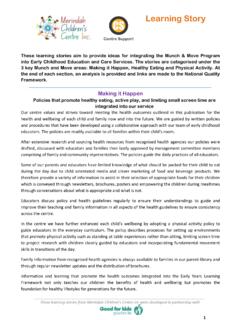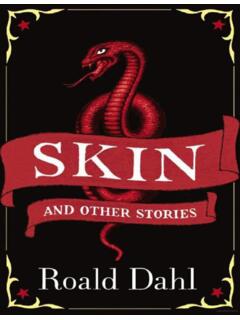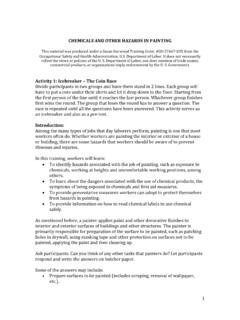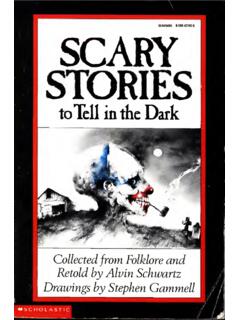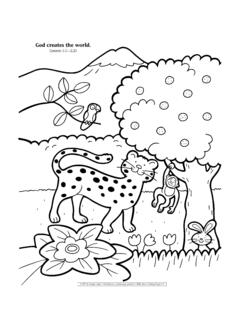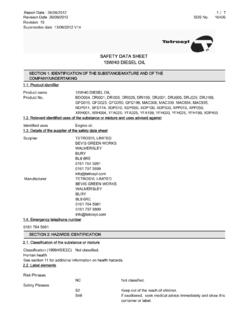Transcription of Teacher Notes/ Activity/Worksheets - Hamilton Zoo
1 Grouping animals - Classification Teacher notes / Activity/Worksheets What can we offer Possible Learning Areas / Achievement Objectives (main focus Science with links to other areas). At Hamilton Zoo we can provide educational opportunities for students of all levels. This programme gives students the opportunity Science Level 1/2. To recognise that living things can be grouped into science- Living World - Ecology based classifications. - Recognise that living things are suited to their particular To investigate the many ways animals can be grouped. habitat. Living World - Evolution Key Competencies - Recognise that there are lots of different living things in the world and that they can be grouped in different ways. Participating and Contributing students are given the opportunity to see how zoos contribute to the conservation of animals. Using Language, Symbols and Text - students will explore animal Level 3/4. behaviour and habitat through visual, oral and written text and Living World - Ecology communicate findings in a variety of formats.
2 - Explain how living things are suited to their particular Relating to others students will be able to listen actively to each habitat and how they respond to environmental changes, both natural and human-induced. other , recognise different points of view and share ideas in relation to classifying animals. Living World - Evolution Thinking students will use creative and critical thinking to make sense - Begin to group animals and other living things into science- of observations, information and ideas, which will allow them to based classifications. confidently groups animals. Listening, Reading and Viewing Managing Self students will be self-motivated, follow instructions and English Speaking, writing and Presenting complete tasks. Mathematics Statistics, Number, Values The Arts Music, Visual Arts Innovation, Inquiry and Curiosity by thinking critically, creatively, and reflectively. Health and Participation in the wider community Physical Movement Concepts and Motor Skills Science and Technology Respect for themselves, others and animals.
3 Education Classification Page 1 of 13. - They have a beak, two wings and two legs Learning Intentions Reptiles - Respect self, others and the environment - They are cold-blooded - Communicate effectively - They have hard leathery scales - Solve problems efficiently - Most have 4 limbs and a tail (exception here is the snake has no limbs). - Most lay eggs with leathery shells Teacher notes - They have lungs Dividing things into groups on the basis of similarities and differences is Amphibians something that is done every day. Imagine going into a library to find a - They are cold blooded book if there was no grouping: you would have to look through - Young have gills and adults have lungs thousands of books to find the one that you wanted. - Moist scale less skin - Webbed feet Scientist use a similar process to group. There are a couple of - Young live in water, adults live on land groupings before we can look at the animals at the zoo.
4 1. Living or Non-living Fish 2. Plant or animal - They are cold blooded - They live in water Animals can then be broken down into two groups. Vertebrates (those - They have gills with a spine) and invertebrates (those without a spine). Although we - They have scales and fins use invertebrates here at the zoo to feed some of our animals we will - They lay soft eggs be looking at vertebrates. Vertebrates can be split into 5 main groups. Mammals, Amphibians, Warm blooded animals: are able to generate heat internally and Reptiles, Birds and Fish. (please remember for each group there can always be exceptions) maintain a constant body temperature that can differ from the surrounding air temperature. Mammals - They are warm blooded Cold blooded animals: are not able to maintain a constant internal - They have fur, hair or wool body temperature. The temperature of cold blooded animals is - They give birth to live young (exception here is that platypus and echidna lay determined by the temperature of the surrounding environment.)
5 An eggs) example of this is the reptile that needs to sit in the sun to warm up - The mother feeds milk to their young and sit in holes in the ground to cool down. - They all have lungs Birds Vocabulary - They are warm blooded Vertebrate, invertebrate, cold-blooded, warm-blooded, vertebra, - They have feathers species, amphibians, mammals, reptiles, fish, birds, regulation, - They lay eggs with hard shells endotherms, ectotherms, adaptation, aquatic, carnivore, herbivore Classification Page 2 of 13. Pre-visit Learning activity What group do I belong to? - Think about the different ways things around us can be grouped. Ask the class to choose everyday items like buttons or pencils and group them in What group do I come from?? as many different ways they can think of. This game/ activity can be used as a group or individual activity at - Find out the names of students' pets. Can they classify the pets just from school.
6 Their names? Get them to draw their pets; is it easier to classify them now? - Get students to cut out animal pictures from magazines. Can they put Cut out cards (see below) and get students to try and place these in them into piles of similar ones? Discuss the problems that arise. Get the correct groups. This activity could be used as a before view and them to think about body coverings, breeding strategy and mode of after view. It is also a way of introducing some of the vocabulary breathing. used when classifying animals. - Make students aware of the difference between vertebrates and invertebrates. - activity What group do I come from? (see activity details). References and Resources Learning at the Zoo Animal Classification Game - - Zoo educator can reinforce classifying of animals. Look at the 5 different This webpage has facts about each animal group but also an interactive online groups of vertebrates. Look at examples they may find here at the zoo grouping game.
7 And talk about their special features. A-Z Animals - - worksheet Observing animals This webpage is full of animal information including classification/ taxonomy. - worksheet - Where can I hide? - worksheet Observing Animals Who Am I? by Gervase Phinn, 2012 (picture book). - worksheet - Bird, reptile, mammal, amphibian or fish? - worksheet Who am I? - Scavenger Hunt Mammals - #t=53. Discover Channel Clip - Choose animals to sketch the patterns on their fur, skin etc. Classification of Species - discoveries/ Post-visit Learning Science Channel Clip - worksheet Fur, feathers, skin or scales? 1. Mammals: Investigating a Group of Animals - .. - worksheet Classifying vertebrates Titles and concept overviews - worksheet Classification Key - Design a classification flow chart with the understanding that you have of each animal. Classification Page 3 of 13. Classifying Vertebrates Vertebrates all have similarities and differences.
8 This makes grouping clearer. Get students to answer the question first then list animals at the zoo that belong to each group. What is my body What do I use to How do I have Am I warm-blooded Animals of this group covering? breathe? babies? or cold-blooded? Fish Amphibian Reptile Bird Mammal Classification Page 4 of 13. Where can I hide? Camouflage Can you put animals you see at the zoo into the right habitat? Look at the animal signs for your answers or their colourings/markings of their fur or skin may give you a clue . Savannah Grasslands Rainforest Bush Wetlands *answers can also be found on our website under each individual animal Classification Page 5 of 13. Fur, feathers, skin or scales? Draw lines to connect animal coverings with animal groups and animals. Fur Feathers Scales Skin 1. fish reptile amphibian mammal bird Classification Page 6 of 13. What group do I come from? ( activity cards page 1 of 3 Cut out cards to use for activity ).
9 I can be I carry babies I have a Babies are Mammals backbone covered in in my fed milk fur/wool/hair stomach Most animals I am warm I have ear I am warm I have lungs in this group blooded flaps to touch live on land I have a I am covered I am warm Birds backbone in feathers I lay eggs blooded My eggs have I am warm to Most in this I have lungs hard shells touch group can fly Classification Page 7 of 13. What group do I come from? ( activity cards page 2 of 3 Cut out cards to use for activity ). My eggs are I have a I am cool to Reptiles backbone touch I lay eggs leathery to touch Most in this My body is I am cold group live on I have lungs covered in blooded leathery scales land My eggs are I have a Young have Amphibians I lay eggs soft jelly backbone gills covered Adults have Young live in Most do not I am cold to I am cold lungs water have scales touch blooded Classification Page 8 of 13. What group do I come from?
10 ( activity cards page 3 of 3 Cut out cards to use for activity ). I have a Fish backbone Live in water I lay eggs I have gills I have cartilage I am covered I am cold My eggs are I have fins skeleton instead in scales blooded soft of bone I have I have no I can have 6 I can have Invertebrates hemolymph backbone or more legs many eyes instead of blood I can have I can be I can be tiny Some in this feelers, stings or brightly but don't get antennae group can fly coloured very big Classification Page 9 of 13. Observing animals Use this table to observe the animals while at the zoo and then find ways to group them. ANIMAL COVERING FOOD LIMBS TAIL SIZE. human skin, hair plants, meat 2 arms, 2 legs no medium giraffe ostrich tiger kea gecko rhino frog insects adults no fish wet scales plants, meat none yes mainly small chimp tui Looking at the characteristics of the animals above can you find different ways to group the animals?

